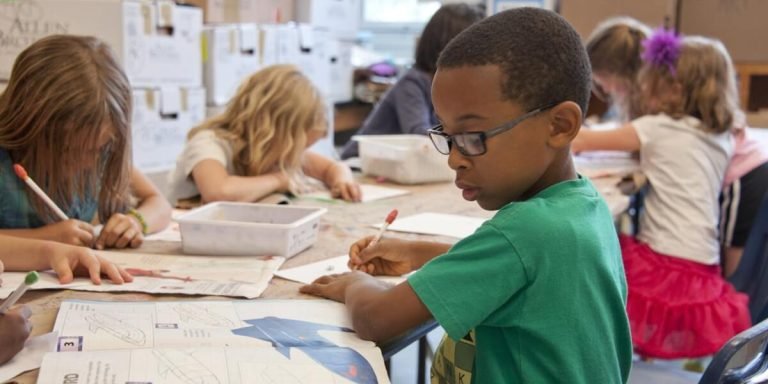7th and 8th Graders: Navigating the Challenges of Middle School Education
Navigating the waters of middle school education can be a tricky affair, especially when it comes to 7th and 8th graders. This crucial stage marks the transition from childhood to adolescence where subjects become more complex, social pressures increase, and there is an overall step-up in academic expectations.
In this whirlpool of changes, children are often expected to exhibit higher-order thinking skills such as problem-solving capabilities or abstract reasoning powers – demands that may appear sudden and overwhelming. This blog post aims to shed light on how parents and educators alike can assist these young learners navigate through their educational traverse successfully.
Did you know?
Research shows that 7th and 8th graders who regularly engage in age-appropriate, educational games can improve their problem-solving skills by up to 20%. This enhancement can significantly help them navigate the academic challenges of middle school.
Transitioning from Elementary: The Challenges for 7th Graders
The transition from elementary to middle school often comes with an array of challenges, particularly for 7th graders. It is a period filled with compatibility complexities as they navigate the bigger pond of seventh grade away from their erstwhile smaller environment.
In 2023, technology is transforming teaching methods in middle school for seventh and eighth graders. Software tools designed to enhance learning experiences for twelve to fourteen-year-olds include:
- Interactive quizzes on mathematics problem-solving techniques
- Visual presentations explaining different science experiments
This transformation makes abstract topics tangible and easy to understand for any student.
Adapting to Increased Academic Rigor
The transition from elementary school to middle school is often a daunting experience for many 7th and 8th graders. As they step into the unfamiliar realms of higher education, one key challenge that most students grapple with is adapting to the increased academic rigor.
Middle schools in our current educational landscape come with an enhanced focus on specialized subjects. Math becomes more than just simple addition and subtraction; it delves deeper into algebraic concepts. Science evolves beyond basic facts about earth & space, evolving to involve detailed studies around physics or biology.
Similarly, language arts get rigorous too as children are introduced to complex prose and poetry, including nuances like metaphorical meanings.
Adding another layer of complexity is technology integration in education which has become a crucial aspect considering how embedded digital tools have become in every facet of life today.
A significant number of classrooms across USA now include elements such as online collaborative projects or virtual reality field trips within their curricula models – so that pupils can better acquire 21st-century skills even while studying traditional topics.
However enjoyable these new learning avenues may seem at first glance though, understanding them requires some effort from young scholars because each software tool comes its own set of features/functions/rules etcetera.
Students begin to face higher expectations for self-management during this phase. They encounter heavier homework and assignments that demand more advanced thought processes, creativity, and research abilities than those in the elementary system, which usually applies less pressure.
Navigating Social Dynamics in Middle School
For 7th and 8th graders, transitioning from elementary to middle school is often a significant period of change. One of the critical aspects that they need to navigate during this transition stage are social dynamics in middle schools.
Middle school can be both an exciting and challenging phase for kids as their interaction space expands vastly. The complex structure of relationships goes beyond mere friendship circles – it involves interactions with teachers, student council members, club mentors, sports teams etc., all involving different sets of expectations.
Parents should help their children understand new roles and responsibilities to ensure they actively thrive within them. Here are some ways you can accomplish this:
1. Encourage Communication: Regularly communicating with your child about their day promotes openness concerning any social issues they’re experiencing at school. This helps identify any potential problems early on before it escalates into something more serious.
2. Teach Empathy: Empathetic behavior not only helps create stronger friendships but also builds character over time – a trait essential for personal growth among our young generation navigating through the digital era.
3.Foster Respectful Behavior: Reinforce how respecting others’ differences contributes towards healthier relationship building—be it race or ethnicity related diversity; or varied interests like gaming vs outdoor sports.
4.Promote Problem Solving Skills : Equip your child with problem-solving skills- teaching them ways to handle conflicts respectfully without resorting to confrontations could prove greatly beneficial in handling tricky peer pressure situations adeptly.
The Role of Technology in Enhancing 8th Grade Learning
As we traverse through the digital age, technology plays an increasingly influential role in shaping and enhancing middle school education. In particular, 7th and 8th graders are at a crucial stage where integrated technological tools can significantly improve their learning experience.
With well-structured online platforms making comprehensive curriculum readily accessible to students, it’s clear that technology has become intertwined with education now more than ever. Students in the 8th grade employ various tech-based resources such as interactive study materials or even AI-powered tutoring! These methods not only make studies engaging but also ensure personalized care for each child based on their individual strengths and weaknesses.
Moreover, mastering these latest technologies enhances critical thinking skills among youngsters while preparing them simultaneously for higher academic pursuits which will inevitably require technological competency. Thus when adopted wisely in pedagogy practices today, this digital transformation stands as a powerful catalyst to gear up our kids towards tomorrow’s advanced world.
Incorporating Educational Apps and Platforms
Integrating technology into education has been a significant move towards enhancing learning experiences, particularly for 7th and 8th graders. The use of educational apps and platforms is proving to be an innovative trend in middle school education.
One area where we see a noticeable impact is the establishment of personalized learning environments. Apps such as ‘Khan Academy’ provide customized lessons on different subjects aligned with students’ unique needs and pace. Such resources are instrumental for both enrichment or intervention purposes, giving teachers room to cater their class instruction more efficiently.
Immersive classroom experiences have also become common thanks to virtual field trip applications like Google Expeditions that capture student’s interest far beyond textbook boundaries. Educational tools including VR headsets bring exploration-based knowledge right at students’ fingertips allowing these young minds to experience historic events or panoramic views of distant locations from comfort of their classrooms.
Another key role played by tech-integrated teaching includes facilitating better teacher-parent communication through platforms like ClassDojo which help keep parents aware about child’s progress in real time along with offering solutions when it comes down parent-teacher meetings scheduling challenges that often arise during regular academic year schedule .
Preparing for Digital Citizenship and Safety
Technology integration in education has transformed middle school learning experiences. Education now extends beyond textbooks; embracing apps, virtual classrooms, simulations, multimedia presentations are common practice.
Online resources offer incredible opportunities for students to explore topics they’re passionate about at a deeper level. For example, instead of just reading about space exploration in a science textbook’s chapter on astronomy , students can virtually visit NASA websites or use interactive Space simulation apps to enhance their comprehension.
However, this increased internet usage among young learners comes with its own set of challenges – one being cyber-safety concerns. It’s essential that while introducing technology into educational curricula we also educate youngsters about potential dangers lurking online – such as cyberbullying and invasion privacy .
Encouraging them to be respectful towards others’ opinions during collaborative e-learning sessions helps foster healthy communication skills within the cyberspace environment also emphasis should be given proper netiquette etiquette all times which will help them become more compassionate mature individuals formal settings too!
Extracurricular Activities: Shaping Well-Rounded 7th and 8th Graders
The impact of extracurricular activities on the holistic growth and development of 7th and 8th graders can’t be disputed. In an era where technology is deeply woven into our daily lives, integrating it within these activities leads to more tangible learning experiences for middle school students. Activities outside the regular curriculum offer an avenue for stimulating interest in technology while honing young minds’ critical problem-solving skills.
These out-of-class engagements are not only about enriching students academically, but they’re also shaping them socially and emotionally. Whether a child picks up coding or robotics as their preferred activity or chooses digital art or online journalism – each exposure helps children understand real-world applications of technology better. They begin to see how tech-tools aren’t just devices that power games or stream videos; instead, they become tools that solve problems, transform ideas into realities – even change societies.
Moreover, such integrations help prepare today’s 7th and 8th graders for technological advances yet to come in this rapidly evolving world we inhabit since now house jobs yet unheard of due to AI advancements by year 2023. These opportunities thus foster future-ready learners who evolve from being mere consumers of information to creators capable enough with building upon new-age technologies as part-and-parcel life contributions.
Balancing Academics with Interests Outside the Classroom
In an era where academics are heavily emphasized, finding a balance between schooldays and interests outside the classroom is critical in shaping well-rounded 7th and 8th graders. As we progress into 2023, technology integration has become increasingly important within middle school education.
Middle school-age children should be encouraged to develop their hobbies while also focusing on academic achievements. This involves coordinating schedules efficiently so that extracurricular activities don’t overlap or interfere with schooling hours – thus generating a harmonious blend of both worlds.
One essential approach is providing students access to educational technologies such as tablets or computers after-school for homework completion and additional learning research. With age-appropriate controls enabled, these devices can promote responsible digital behavior among students whilst complementing their study time effectively uplifting scholastic performance significantly.
Schools are now considering online platforms which offer more than just one-dimensional teaching methodologies but enhance student engagement through interactive lessons simulating real-world contexts – giving kids a chance to apply what they’re learning inside classrooms towards solving everyday conundrums strengthening comprehension deeper into subject matters subtly integrating fun elements fostering better retention rates hence ensuring progressive development graphically backed by consistent data-driven results.
The Impact of Sports, Arts, and Clubs on Adolescent Development
Middle school, particularly the 7th and 8th-grade years, is a crucial stage in childhood education. It propels students towards herculean developments: physically, emotionally, socially as well as intellectually. The classroom environment plays an important role; however extracurricular activities such as sports, arts and clubs are equally essential for shaping these young minds into well-rounded individuals.
Sports participation promotes physical fitness among adolescents while teaching them critical life skills of teamwork and leadership. A study conducted in 2023 indicated that student-athletes perform better academically due to enhanced discipline instilled by their rigorous training schedules. Additionally, exposure to diverse teams fosters inclusionary perspectives at this susceptible age enhancing emotional intelligence amongst our competitive “7th & 8th graders”.
Visual or performing arts channels have been noted to improve children’s cognitive abilities remarkably by enabling self-expression creatively while nurturing individualistic thinking capabilities universally lauded in current times’ gig economy workforce matrix.
Club memberships encourage socialization providing safe spaces outside regular classrooms helping build supportive peer relationships absolutely necessary during this tumultuous adolescent period fostering collaborative learning skills strengthening socioeducational bonds between students often leading improving grades over time.
Conclusion
In the grand voyage of education, 7th and 8th graders are in an exciting yet challenging phase. As they navigate through middle school years, it’s crucial that their curiosity is nurtured while also steering them towards resilience and self-confidence. Remember, each challenge faced offers a new opportunity for development – because even rough seas make skilled sailors.
We encourage you to continue exploring our website where we share more insights on nurturing young minds during these critical educational stages. We offer a variety of resources aimed at helping both parents and educators alike create enriching learning environments for children everywhere. Yes indeed – together let’s harness the tremendous potential hidden within every dilemma encountered by your amazing 7th or 8th grader!







